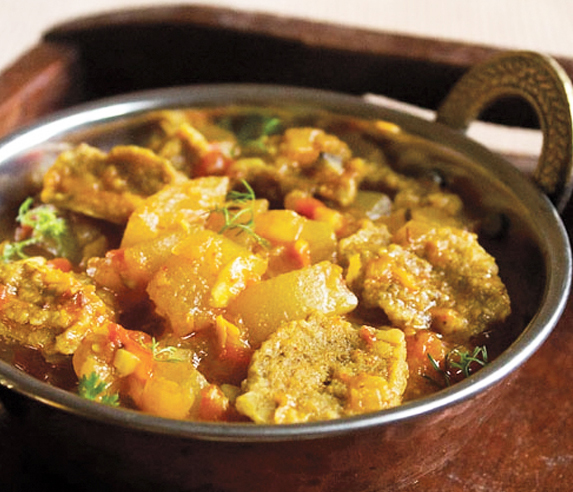Mama’s Punjabi Recipes: Ghia te Wadiyan (Bottle Gourd Squash & Dumplings)
Although there are many types of gourd or squash, there are usually only two types that are readily available in most Indian marketplaces. One is the long, smooth and stout, leaf green type which resemble a bottle (hence its English name), which Punjabis call ghia or kadoo and others call doodhi or lauki. The other type called tauri are short, thinner and dark green ones and are commonly called zucchini in the US.
Both types of squash are made in India, with different ways because their taste and texture is so far apart. When cooked, both reduce in volume, but the ghia has a firmer, buttery taste while the tauri is softer, sweeter and slightly creamy. Although these can be made alone, for the Indian palate at least, they both require the proper type of spices to give them added flavor.
There are two ways that Punjabis prefer to make ghia: either in kofte (deep-fried balls) marinated in a curry or by itself with a little gravy. Sautéed ghia with the right spices can be a satisfying dish if it has the right tenderness and is cut in strips. It is usually not served as the main dish, but a side dish to be relished with hot rotis.
But for a true flavor that will reach the heart of any Punjabi, ghia made with some wadiyan (lentil dumplings) are incomparable. The spiciness and aroma of the wadiyan permeate through the dish and give an otherwise plain vegetable an added tanginess that makes the dish outstanding. Unfortunately for those who crave this type of food, it is not on the menu of any restaurant in India or the US that I have been to.
Tender ghia cooks fast in its own vapor in a kadai (wok); just be careful it doesn’t get too mushy. Hard ghia with plenty of seeds should be cooked longer with a little water and over low heat in a saucepan to become tender. There is no need to add piyaaz (onions), adrak (ginger) or lasan (garlic) to this dish since the wadiyan bring out the taste.
Ingredients:
1 medium ghia (squash) – choose ones tender in the middle
1 or 2 Punjabi wadiyan (lentil dumplings) – spiciness to taste
2 tbsp tael (olive oil or vegetable oil)
½ tsp haldi (turmeric powder)
Spices to taste: 1 tsp namak (salt), 1 tsp mirch (red pepper)
Directions:
1. Cut off the top stalk, peel the ghia and then cut into ¼ inch thick wedges. Wash thoroughly and let them drip dry in a strainer.
2 .In a kadai, heat the oil and throw in the wadiyan and stir till they are slightly brown. Add ½ cup of water and cover over low heat for 5 minutes so that the wadiyan become soft.
3. Now add the cut ghia, sprinkle the salt, red pepper and turmeric, stir till it is coated. Cover and let it cook in its own steam for 5 minutes over medium heat.
4. Take the cover off and check if the ghia has let off enough vapor and is tender. If the water is low, turn off heat and cover; if not then let it cook covered for 10 more minutes over low heat till the water is reduced. Stir gently to make sure it doesn’t stick.
5. For best taste, serve with hot rotis or crispy paranthas.
MAMA’S TIP OF THE WEEK
CHOOSE VEGETABLES CAREFULLY FOR EASY COOKING
The ease of cooking dishes and their taste depends a great deal on the condition of the vegetables. This requires some experience but in general it boils down to knowing whether the vegetable is hard or soft and what this means for its state inside. If it is too hard, filled up and stout, then chances are that it has ripened in the sun and has a lot of fiber and seeds. Cooking with ripened vegetables takes not only more effort to peel and cut, but also more time and care to cook.
This is especially true of kerela (bitter gourd), ghia (bottle gourd squash), bhindi (okra) and baingan (eggplant). It is best to choose these vegetables long and tender which means they have few seeds, but if too shallow or soft in the middle it means that they make be hollow and not well formed. Bhindis should not be too large or have hard edges.
Shakuntla Malhotra is a skilled cook of Punjabi dishes made in the old-fashioned style that she learnt as a young woman in her ancestral home in Lyallpur, India before it became part of Pakistan after the Partition in 1947. People have often admired her cooking for its simplicity and taste that comes with each mouthful. Even in her mid-eighties, she continues to cook daily and agreed to share some of her delectable Punjabi recipes.


